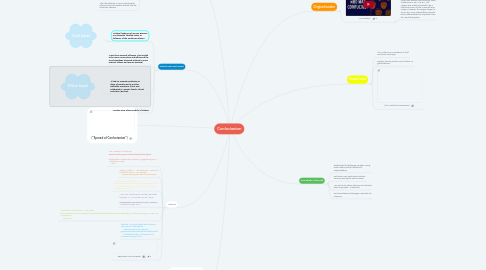Confucianism
Door Aiden Bourgeau


1. ("Spread of Confucianism")
2. Political and Social Impact
2.1. -Political leaders such as Han Emperor Wu ultimately labelled states as followers of the Confucian religion.
2.1.1. Social Impact
2.2. -Came from imperial influence. This tended to be more conservative and influenced the social standings alongside political in many imperial villages and groups (Berling).
2.3. -It had no separate institution or place of worship and is a rather malleable practice in that it was celebrated in "society, family, school, and state" (Berling).
2.3.1. Political Impact
2.4. -Leaders were often symbols of religion
3. Where did it spread and why?
3.1. Due to China's influence over east asia as being the oldest and most imitated civilization almost all East asian regimes endorsed Confucianism as their ideologies as well.
3.2. Confucianism started when it was adopted by the Han dynasty (260 B.C.E. - 220 C.E.) where it became the dominate political ideology.
3.3. Confucianism spread through east asia largely by consensual means rather than by conquest or conversion
3.4. During the period of 1868-1945 the Japanese military government began to persecute Christian and buddhist culture in neighbouring countries and within Japan.
3.5. After the setbacks of WW2 post imperial reformers tried to breathe new life into the Confucian tradition.
4. Citations
4.1. The Analects of Confucius. www.ancient-origins.net/sites/default/files/styles/ large/public/Analects-of-Confucius_2.jpg?itok=8j-v9CVX. Accessed 25 Sept. 2017.
4.2. Berling, Judith A. "Confucianism." Center for Global Education, Asia Society, asiasociety.org/education/confucianism.
4.3. Confucius Portrait. Patheos, wp.production.patheos.com/blogs/jacksonwu/files/ 2016/07/Konfuzius-1770-CC-wikimedia-1.jpg. Accessed 25 Sept. 2017.
4.4. "Who was Confucious?" Ted-ed, uploaded by Bryan W. Van Norden, 27 Oct. 2015, www.youtube.com/watch?v=wFt_VGG0kJU. Accessed 25 Sept. 2017.
4.5. "Spread of Confucianism." Time Toast, s3.amazonaws.com/s3.timetoast.com/public/uploads/photos/5407457/spread_of_confucianism.jpg?1476881168. Accessed 25 Sept. 2017.
4.6. Stanford. "Cultural Beliefs and Practices: The Role of Confucianism." Stanford School of Medicine, geriatrics.stanford.edu/ethnomed/chinese/ fund/beliefs/other_influences.html. Accessed 25 Sept. 2017.
4.7. Exploration and Conquest
5. Confucian Art
6. Sacred texts
6.1. The Analect is a compilation of all of Confucius' teachings.
6.2. Explains how to practice moral virtues, or good behavior.
6.3. (The Analects of Confucious)
7. Origins/founder
7.1. (Van Norden)
7.1.1. Confucianism was founded by Master Kong, later named Confucious by Jesuit missionaries in 551-479 B.C. The religion was initially intended to be a reformed version of the unnamed Zhou religion; however, the religion began to form into a more individualistic practice which differentiated the inspiration from the new belief-system.

